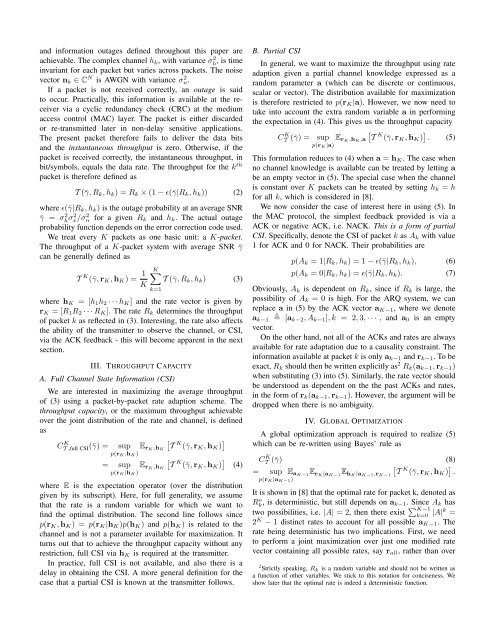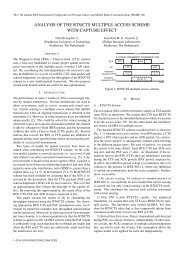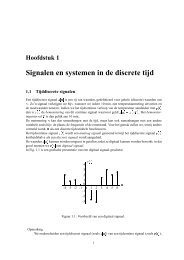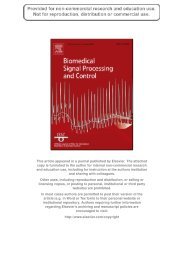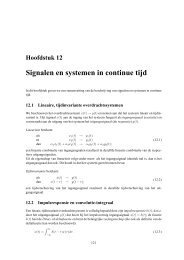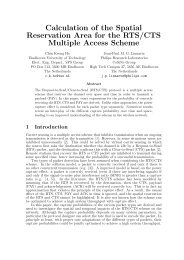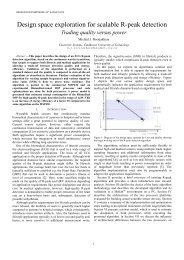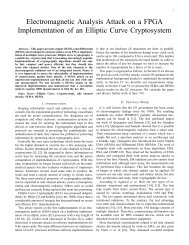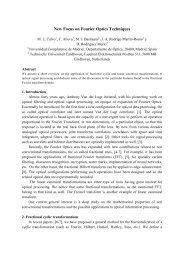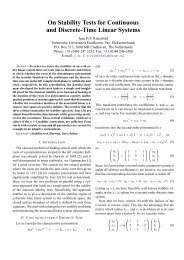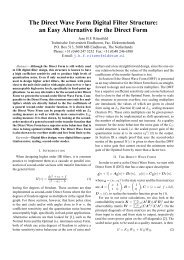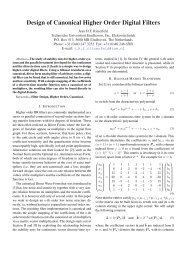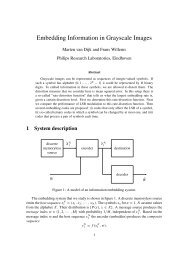Rate Adaptation in Time Varying Channels using Acknowledgement ...
Rate Adaptation in Time Varying Channels using Acknowledgement ...
Rate Adaptation in Time Varying Channels using Acknowledgement ...
You also want an ePaper? Increase the reach of your titles
YUMPU automatically turns print PDFs into web optimized ePapers that Google loves.
and <strong>in</strong>formation outages def<strong>in</strong>ed throughout this paper are<br />
achievable. The complex channel h k , with variance σh 2 , is time<br />
<strong>in</strong>variant for each packet but varies across packets. The noise<br />
vector n k ∈ C N is AWGN with variance σn.<br />
2<br />
If a packet is not received correctly, an outage is said<br />
to occur. Practically, this <strong>in</strong>formation is available at the receiver<br />
via a cyclic redundancy check (CRC) at the medium<br />
access control (MAC) layer. The packet is either discarded<br />
or re-transmitted later <strong>in</strong> non-delay sensitive applications.<br />
The present packet therefore fails to deliver the data bits<br />
and the <strong>in</strong>stantaneous throughput is zero. Otherwise, if the<br />
packet is received correctly, the <strong>in</strong>stantaneous throughput, <strong>in</strong><br />
bit/symbols, equals the data rate. The throughput for the k th<br />
packet is therefore def<strong>in</strong>ed as<br />
T (¯γ,R k ,h k )=R k × (1 − ɛ(¯γ|R k ,h k )) (2)<br />
where ɛ(¯γ|R k ,h k ) is the outage probability at an average SNR<br />
¯γ = σ 2 h σ2 x/σ 2 n for a given R k and h k . The actual outage<br />
probability function depends on the error correction code used.<br />
We treat every K packets as one basic unit: a K-packet.<br />
The throughput of a K-packet system with average SNR ¯γ<br />
can be generally def<strong>in</strong>ed as<br />
T K (¯γ,r K , h K )= 1 K<br />
K∑<br />
T (¯γ,R k ,h k ) (3)<br />
k=1<br />
where h K =[h 1 h 2 ···h K ] and the rate vector is given by<br />
r K =[R 1 R 2 ···R K ].TherateR k determ<strong>in</strong>es the throughput<br />
of packet k as reflected <strong>in</strong> (3). Interest<strong>in</strong>g, the rate also affects<br />
the ability of the transmitter to observe the channel, or CSI,<br />
via the ACK feedback - this will become apparent <strong>in</strong> the next<br />
section.<br />
III. THROUGHPUT CAPACITY<br />
A. Full Channel State Information (CSI)<br />
We are <strong>in</strong>terested <strong>in</strong> maximiz<strong>in</strong>g the average throughput<br />
of (3) us<strong>in</strong>g a packet-by-packet rate adaption scheme. The<br />
throughput capacity, or the maximum throughput achievable<br />
over the jo<strong>in</strong>t distribution of the rate and channel, is def<strong>in</strong>ed<br />
as<br />
CT K [<br />
,full CSI(¯γ) = sup E rK,h K T K (¯γ,r K , h K ) ]<br />
p(r K,h K)<br />
[<br />
= sup E rK,h K T K (¯γ,r K , h K ) ] (4)<br />
p(r K|h K)<br />
where E is the expectation operator (over the distribution<br />
given by its subscript). Here, for full generality, we assume<br />
that the rate is a random variable for which we want to<br />
f<strong>in</strong>d the optimal distribution. The second l<strong>in</strong>e follows s<strong>in</strong>ce<br />
p(r K , h K )=p(r K |h K )p(h K ) and p(h K ) is related to the<br />
channel and is not a parameter available for maximization. It<br />
turns out that to achieve the throughput capacity without any<br />
restriction, full CSI via h K is required at the transmitter.<br />
In practice, full CSI is not available, and also there is a<br />
delay <strong>in</strong> obta<strong>in</strong><strong>in</strong>g the CSI. A more general def<strong>in</strong>ition for the<br />
case that a partial CSI is known at the transmitter follows.<br />
B. Partial CSI<br />
In general, we want to maximize the throughput us<strong>in</strong>g rate<br />
adaption given a partial channel knowledge expressed as a<br />
random parameter a (which can be discrete or cont<strong>in</strong>uous,<br />
scalar or vector). The distribution available for maximization<br />
is therefore restricted to p(r K |a). However, we now need to<br />
take <strong>in</strong>to account the extra random variable a <strong>in</strong> perform<strong>in</strong>g<br />
the expectation <strong>in</strong> (4). This gives us the throughput capacity<br />
CT K [<br />
(¯γ) = sup E rK,h K,a T K (¯γ,r K , h K ) ] . (5)<br />
p(r K|a)<br />
This formulation reduces to (4) when a = h K . The case when<br />
no channel knowledge is available can be treated by lett<strong>in</strong>g a<br />
be an empty vector <strong>in</strong> (5). The special case when the channel<br />
is constant over K packets can be treated by sett<strong>in</strong>g h k = h<br />
for all k, which is considered <strong>in</strong> [8].<br />
We now consider the case of <strong>in</strong>terest here <strong>in</strong> us<strong>in</strong>g (5). In<br />
the MAC protocol, the simplest feedback provided is via a<br />
ACK or negative ACK, i.e. NACK. This is a form of partial<br />
CSI. Specifically, denote the CSI of packet k as A k with value<br />
1 for ACK and 0 for NACK. Their probabilities are<br />
p(A k =1|R k ,h k )=1− ɛ(¯γ|R k ,h k ), (6)<br />
p(A k =0|R k ,h k )=ɛ(¯γ|R k ,h k ). (7)<br />
Obviously, A k is dependent on R k , s<strong>in</strong>ce if R k is large, the<br />
possibility of A k =0is high. For the ARQ system, we can<br />
replace a <strong>in</strong> (5) by the ACK vector a K−1 , where we denote<br />
a k−1 [a k−2 ,A k−1 ],k = 2, 3, ··· , and a 0 is an empty<br />
vector.<br />
On the other hand, not all of the ACKs and rates are always<br />
available for rate adaptation due to a causality constra<strong>in</strong>t. The<br />
<strong>in</strong>formation available at packet k is only a k−1 and r k−1 .Tobe<br />
exact, R k should then be written explicitly as 2 R k (a k−1 , r k−1 )<br />
when substitut<strong>in</strong>g (3) <strong>in</strong>to (5). Similarly, the rate vector should<br />
be understood as dependent on the the past ACKs and rates,<br />
<strong>in</strong> the form of r k (a k−1 , r k−1 ). However, the argument will be<br />
dropped when there is no ambiguity.<br />
IV. GLOBAL OPTIMIZATION<br />
A global optimization approach is required to realize (5)<br />
which can be re-written us<strong>in</strong>g Bayes’ rule as<br />
CT K (¯γ) (8)<br />
[<br />
= sup E aK−1 E rK|a K−1<br />
E hK|a K−1,r K−1 T K (¯γ,r K , h K ) ] .<br />
p(r K|a K−1)<br />
It is shown <strong>in</strong> [8] that the optimal rate for packet k, denoted as<br />
Rk o, is determ<strong>in</strong>istic, but still depends on a k−1. S<strong>in</strong>ce A k has<br />
two possibilities, i.e. |A| =2, then there exist ∑ K−1<br />
k=0 |A|k =<br />
2 K − 1 dist<strong>in</strong>ct rates to account for all possible a K−1 .The<br />
rate be<strong>in</strong>g determ<strong>in</strong>istic has two implications. First, we need<br />
to perform a jo<strong>in</strong>t maximization over just one modified rate<br />
vector conta<strong>in</strong><strong>in</strong>g all possible rates, say r all , rather than over<br />
2 Strictly speak<strong>in</strong>g, R k is a random variable and should not be written as<br />
a function of other variables. We stick to this notation for conciseness. We<br />
show later that the optimal rate is <strong>in</strong>deed a determ<strong>in</strong>istic function.


